tow CHEVROLET ASTRO 2003 Owners Manual
[x] Cancel search | Manufacturer: CHEVROLET, Model Year: 2003, Model line: ASTRO, Model: CHEVROLET ASTRO 2003Pages: 386, PDF Size: 17.31 MB
Page 2 of 386
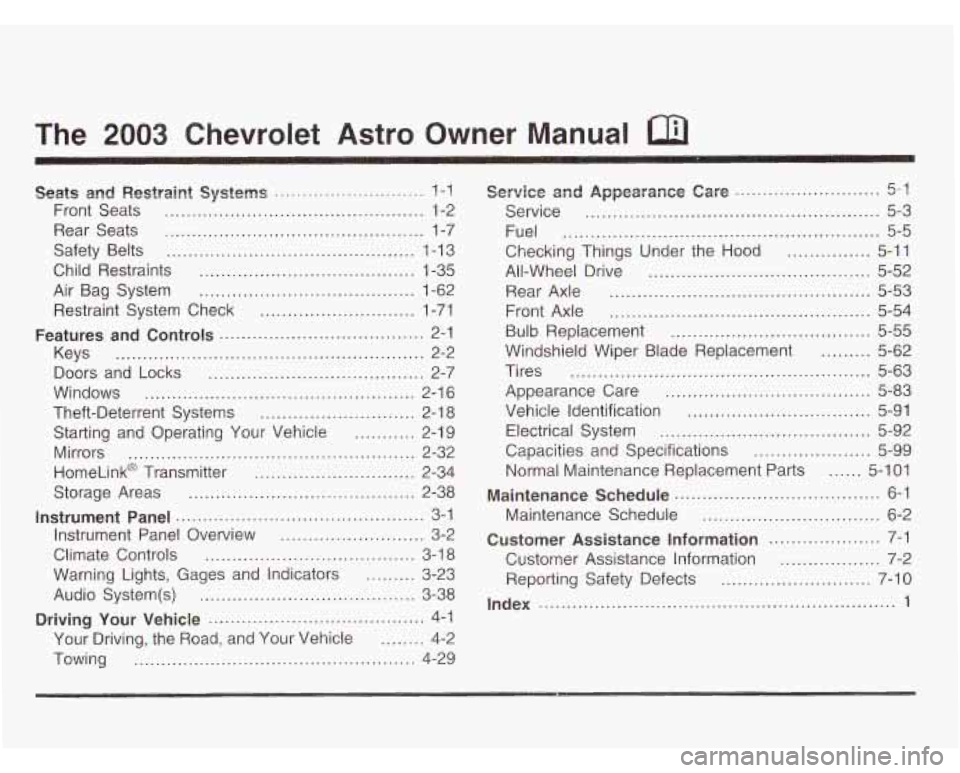
The 2003 Chevrolet Astro Owner Manual
Seats and Restraint Systems ........................... I-!
Front Seats ............................................... 1-2
Rear Seats
............................................... 1-7
Safety Belts
............................................. 1-13
Child Restraints
....................................... 1-35
Air Bag System
....................................... 1-62
Restraint System Check
............................ 1-71
Keys
........................................................ 2-2
Doors and Locks
....................................... 2-7
Windows
................................................. 2-1 6
Theft-Deterrent Systems
............................ 2-1 8
Mirrors
.................................................... 2-32
HomeLink@ Transmitter
............................. 2-34
Features and Controls ..................................... 2-1
Starting and Operating Your Vehicle
........... 2-19
Storage Areas
Instrument Panel .
Instrument Panel
Climate Controls
......................................... 2-38
........................................... 3-1
Overview .......................... 3-2
...................................... 3-18
Warning Lights. Gages and Indicators
......... 3-23
Audio System(s)
....................................... 3-38
Driving Your Vehicle ....................................... 4-1
Your Driving, the Road, and Your Vehicle
........ 4-2
Towing
................................................... 4-29
Service and Appearance Care .......................... 5-1
Service ..................................................... 5-3
Fuel
......................................................... 5-5
All-Wheel Drive
........................................ 5-52
Rear Axle ............................................... 5-53
Front Axle
............................................... 5-54
Bulb Replacement
.................................... 5-55
Windshield Wiper Blade Replacement ......... 5-62
Tires
...................................................... 5-63
Appearance Care
..................................... 5-83
Vehicle Identification
................................. 5-91
Electrical System
...................................... 5-92
Capacities and Specifications
..................... 5-99
Normal Maintenance Replacement Parts
...... 5-1 01
Maintenance Schedule ..................................... 6-1
Maintenance Schedule
................................ 6-2
Customer Assistance Information .................... 7-1
Customer Assistance Information
.................. 7-2
Reporting Safety Defects ........................... 7-10
Checking Things Under
the Hood
............... 5-11
Index ................................................................ 1
Page 9 of 386
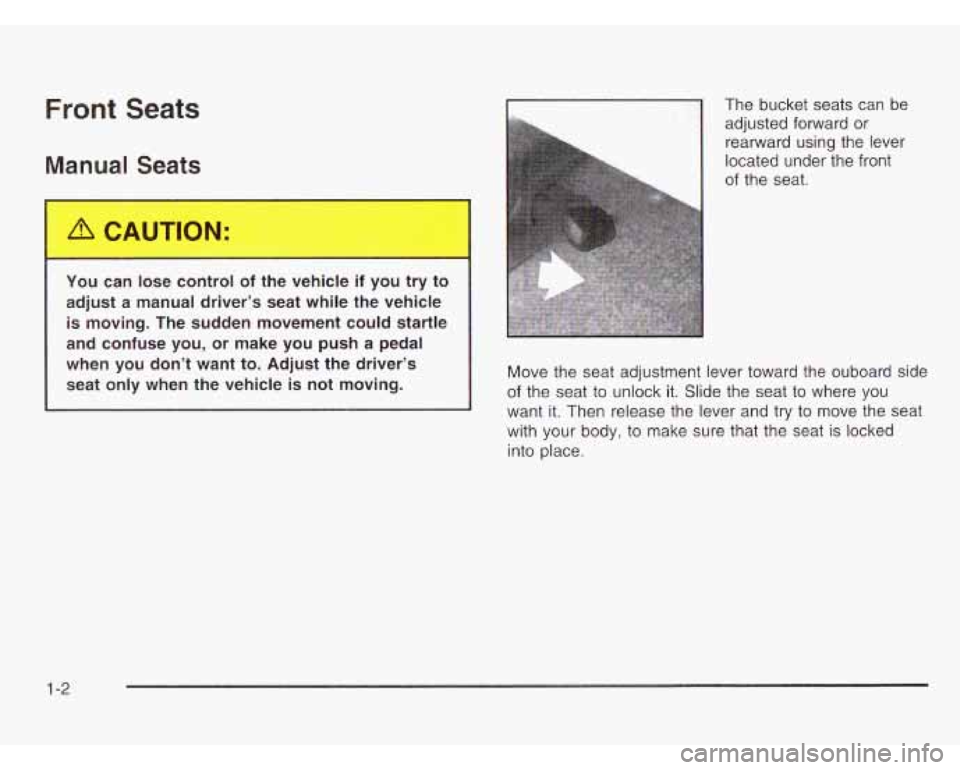
Front Seats
Manual Seats
1 I
The bucket seats can be
adjusted forward or
rearward using the lever
located under the front
You can lose control of the vehicle if you try to
adjust a manual driver’s seat while the vehicle
is moving. The sudden movement could startle
and confuse you, or make you push a pedal
when you don’t want to. Adjust the driver’s
seat only when the vehicle
is not moving. Move the seat adjustment lever toward the ouboard side
of the seat to unlock it. Slide the seat to where you
want it. Then release the lever and try
to move the seat
with your body, to make sure that the seat is locked
into place.
1 -2
Page 10 of 386
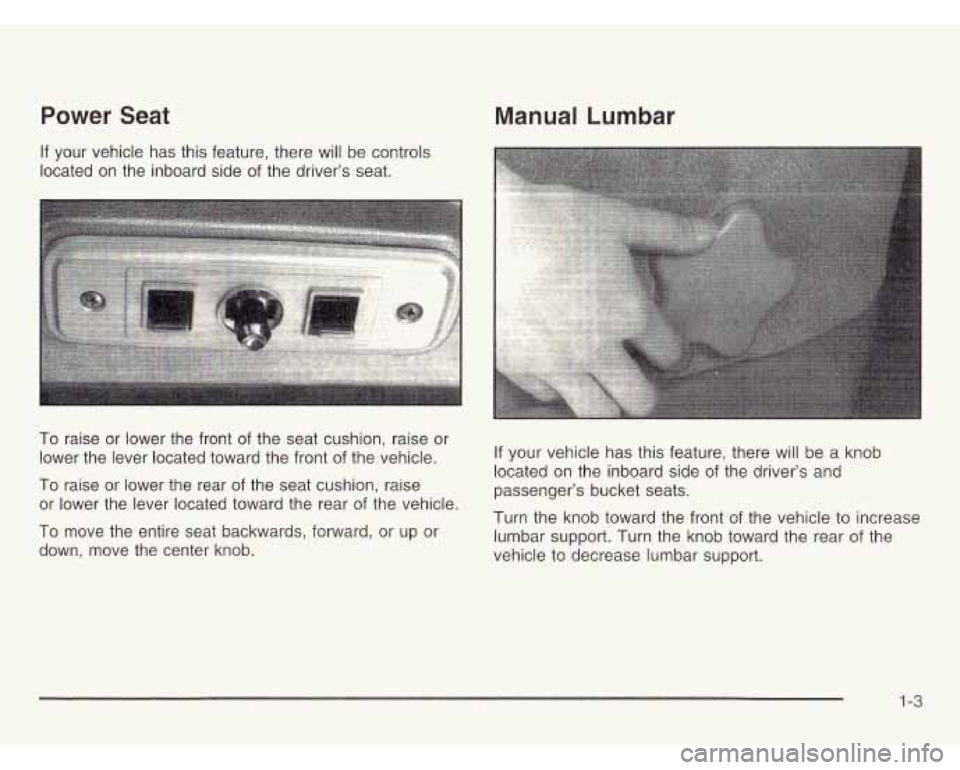
Power Seat
If your vehicle has this feature, there will be controls
located on the inboard side of the driver’s seat.
Manual Lumbar
To raise or lower the front of the seat cushion, raise or
lower the lever located toward the front of the vehicle.
To raise or lower the rear of the seat cushion, raise
or lower the lever located toward the rear of the vehicle.
To move the entire seat backwards, forward, or up or
down, move the center knob.
If your vehicle has this feature, there will be a knob
located on the inboard side of the driver’s and
passenger’s bucket seats.
Turn the knob toward the front of the vehicle
to increase
lumbar support. Turn the knob toward the rear of the
vehicle to decrease lumbar support.
1 -3
Page 13 of 386
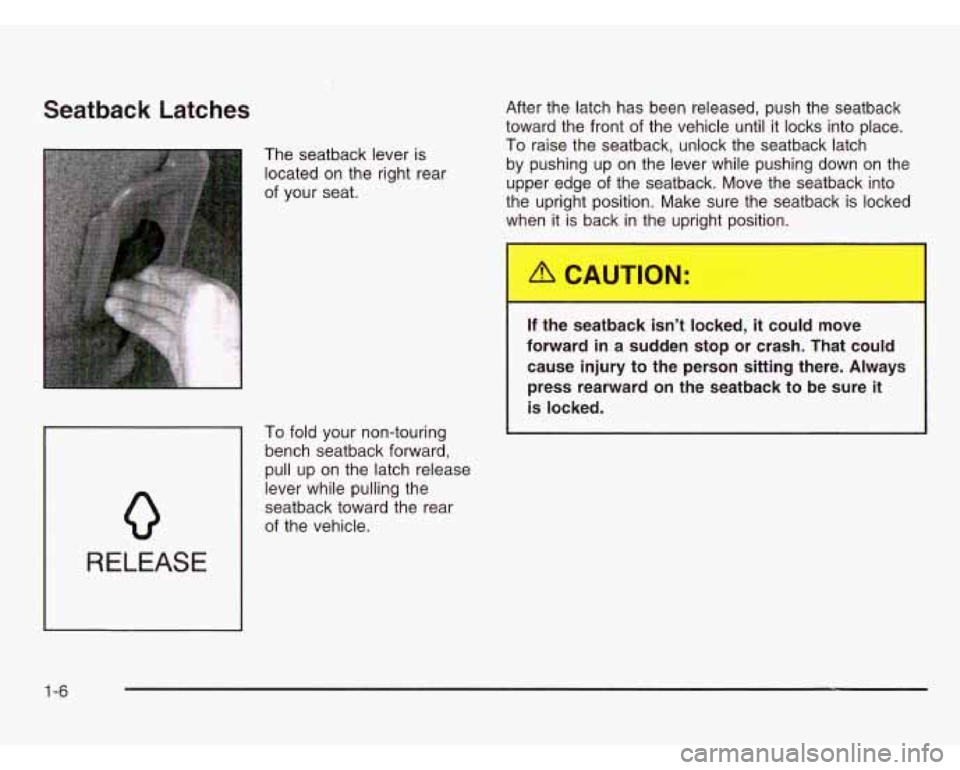
Seatback Latches
The seatback lever is
located on the right rear
of your seat.
0
To fold your non-touring
bench seatback forward,
pull up on the latch release
lever while pulling the
seatback toward the rear
RELEASE
of the vehicle. After the
latch has been released, push the seatback
toward the front of the vehicle until it locks into place.
To raise the seatback, unlock the seatback latch
by pushing up on the lever while pushing down on the
upper edge
of the seatback. Move the seatback into
the upright position. Make sure the seatback is locked
whe
t is back in the upright position.
If the seatback isn’t locked, it could move
forward in a sudden stop or crash. That could
cause injury to the person sitting there. Always
press rearward on the seatback to be sure it
is locked.
1-6
Page 17 of 386
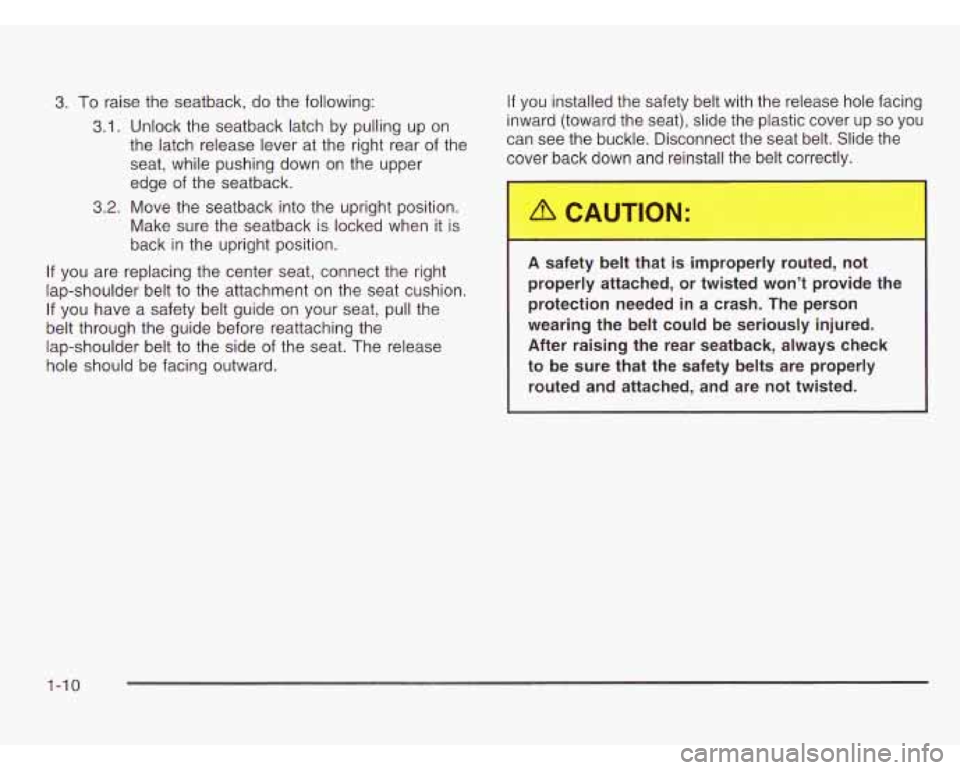
3. To raise the seatback, do the following:
3.1. Unlock the seatback latch by pulling up on
the latch release lever at the right rear
of the
seat, while pushing down on the upper
edge of the seatback.
3.2. Move the seatback into the upright position.
Make sure the seatback is locked when it is
back in the upright position.
If you are replacing the center seat, connect the right
lap-shoulder belt to the attachment on the seat cushion.
If you have a safety belt guide
on your seat, pull the
belt through the guide before reattaching the
lap-shoulder belt to the side
of the seat. The release
hole should be facing outward.
If you installed the safety belt with the release hole facing
inward (toward the seat), slide the plastic cover up
so you
can see the buckle. Disconnect the seat belt. Slide the
cover back down and reinstall the belt correctly.
A safety
--It that __ impropc routed, not
properly attached, or twisted won’t provide the
protection needed in a crash. The person
wearing the belt could be seriously injured. After raising the rear seatback, always check
to be sure that the safety belts are properly routed and attached, and are not twisted.
1-10
Page 18 of 386
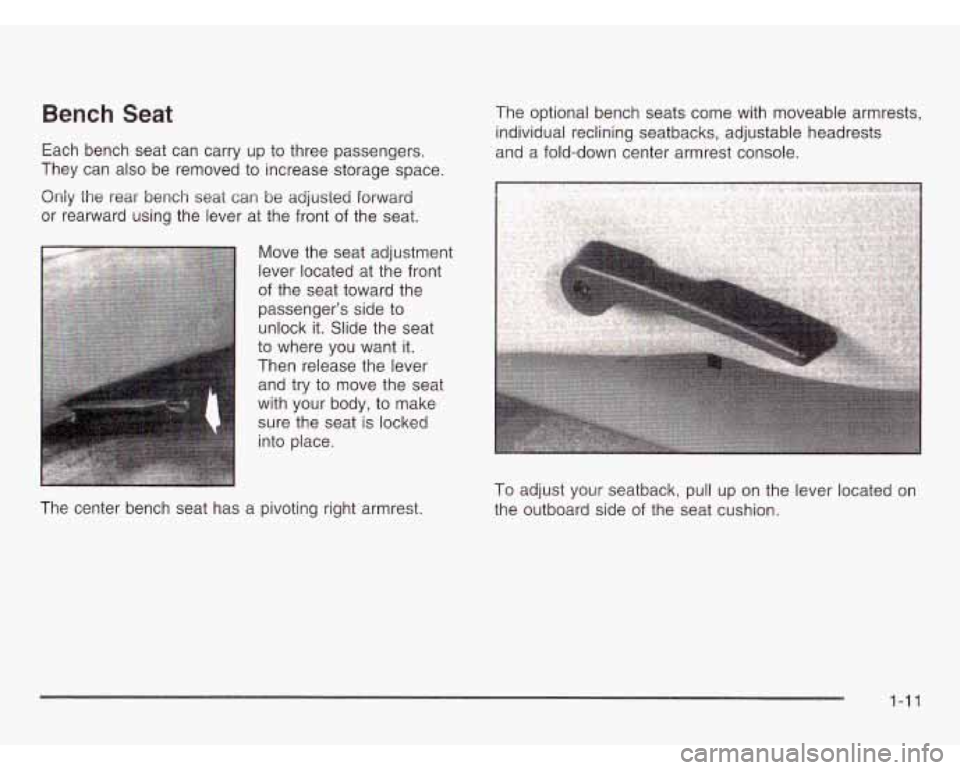
Bench Seat
Each bench seat can carry up to three passengers.
They can also be removed to increase storage space.
Only the rear bench seat can be adjusted forward
or rearward using the lever at the front of the seat.
Move the seat adjustment
lever located at the front
of the seat toward the
passenger’s side to
unlock it. Slide the seat
to where you want it.
Then release the lever
and try to move the seat
with your body, to make
sure the seat is locked
into place. The optional
bench seats come with moveable armrests,
individual reclining seatbacks, adjustable headrests
and a fold-down center armrest console.
The center bench seat has a pivoting right armrest. To
adjust your seatback, pull up on the lever located on
the outboard side of the seat cushion.
1-1 1
Page 43 of 386
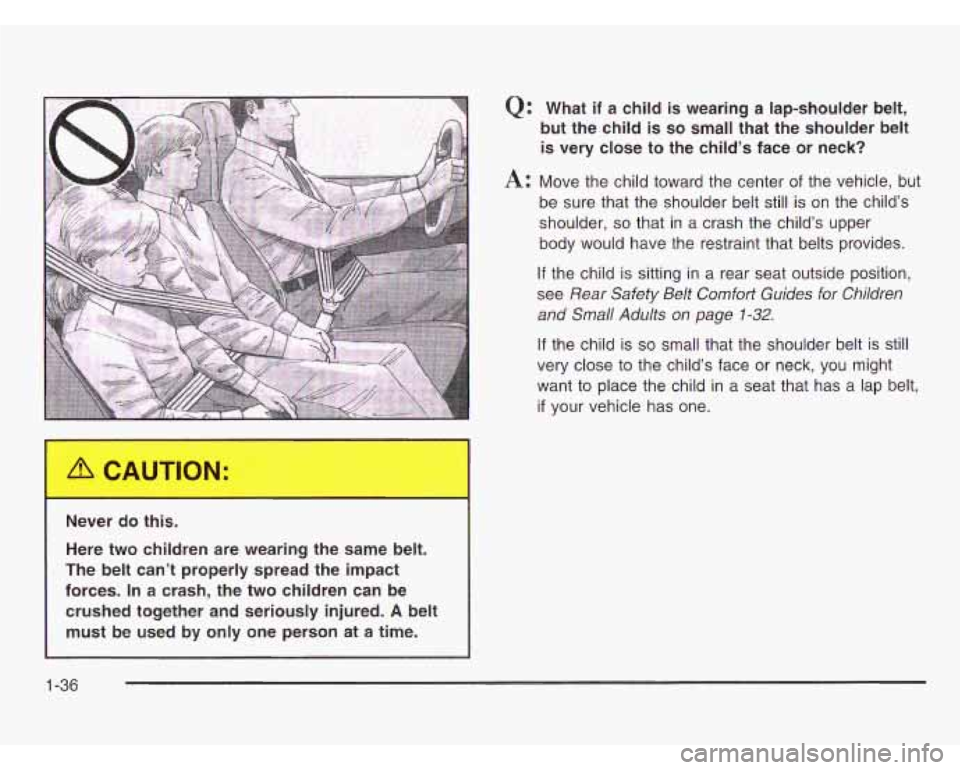
Never do this. Here two children are wearing the same belt.
The belt can’t properly spread the impact
forces.
In a crash, the two children can be
crushed together and seriously injured.
A belt
must be used by only one person at a time.
Q: What if a child is wearing a lap-shoulder belt,
but the child
is so small that the shoulder belt
is very close to the child’s face or neck?
A: Move the child toward the center of the vehicle, but
be sure that the shoulder belt still
is on the child’s
shoulder,
so that in a crash the child’s upper
body would have the restraint that belts provides.
If the child is sitting in a rear seat outside position,
see
Rear Safety Belt Comfort Guides for Children
and Small Adults
on page 1-32.
If the child is so small that the shoulder belt is still
very close to the child’s face or neck, you might
want
to place the child in a seat that has a lap belt,
if your vehicle has one.
1-36
Page 51 of 386
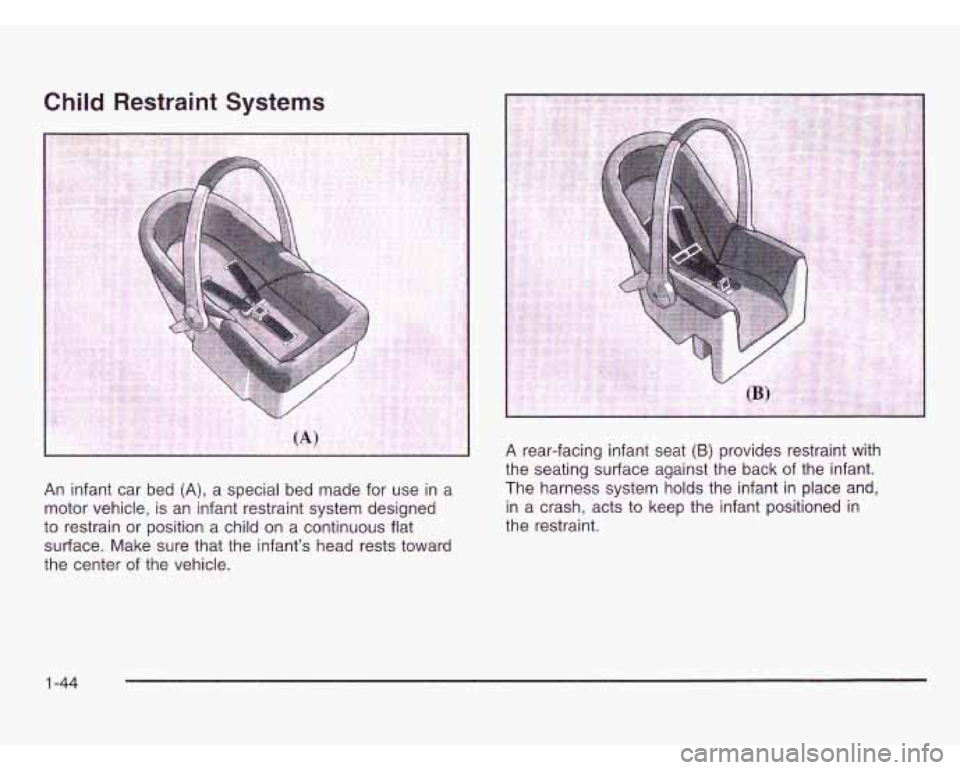
Child Restraint Systems
An infant car bed (A), a special bed made for use in a
motor vehicle, is an infant restraint system designed
to restrain or position
a child on a continuous flat
surface. Make sure that the infant’s head rests toward
the center of the vehicle.
A rear-facing infant seat (B) provides restraint with
the seating surface against the back of the infant.
The harness system holds the infant in place and,
in a crash, acts to keep the infant positioned in
the restraint.
1 -44
Page 74 of 386
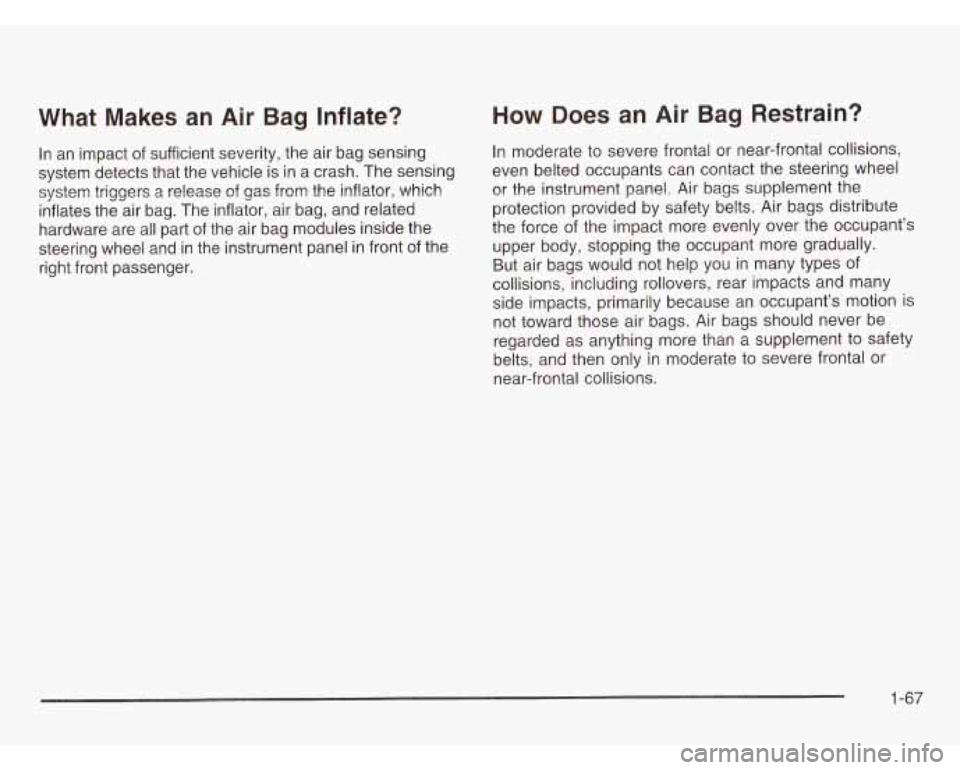
What Makes an Air Bag Inflate?
In an impact of sufficient severity, the air bag sensing
system detects that the vehicle
is in a crash. The sensing
system triggers a release of gas from the inflator, which
inflates the air bag. The inflator, air bag, and related
hardware are all part of the air bag modules inside the
steering wheel and in the instrument panel in front of the
right front passenger.
How Does an Air Bag Restrain?
In moderate to severe frontal or near-frontal collisions,
even belted occupants can contact the steering wheel
or the instrument panel. Air bags supplement the
protection provided by safety belts. Air bags distribute
the force of the impact more evenly over the occupant’s
upper body, stopping the occupant more gradually.
But air bags would not help you in many types
of
collisions, including rollovers, rear impacts and many
side impacts, primarily because an occupant’s motion is
not toward those air bags. Air bags should never be
regarded as anything more than a supplement to safety
belts, and then only in moderate to severe frontal or
near-frontal collisions.
1-67
Page 87 of 386
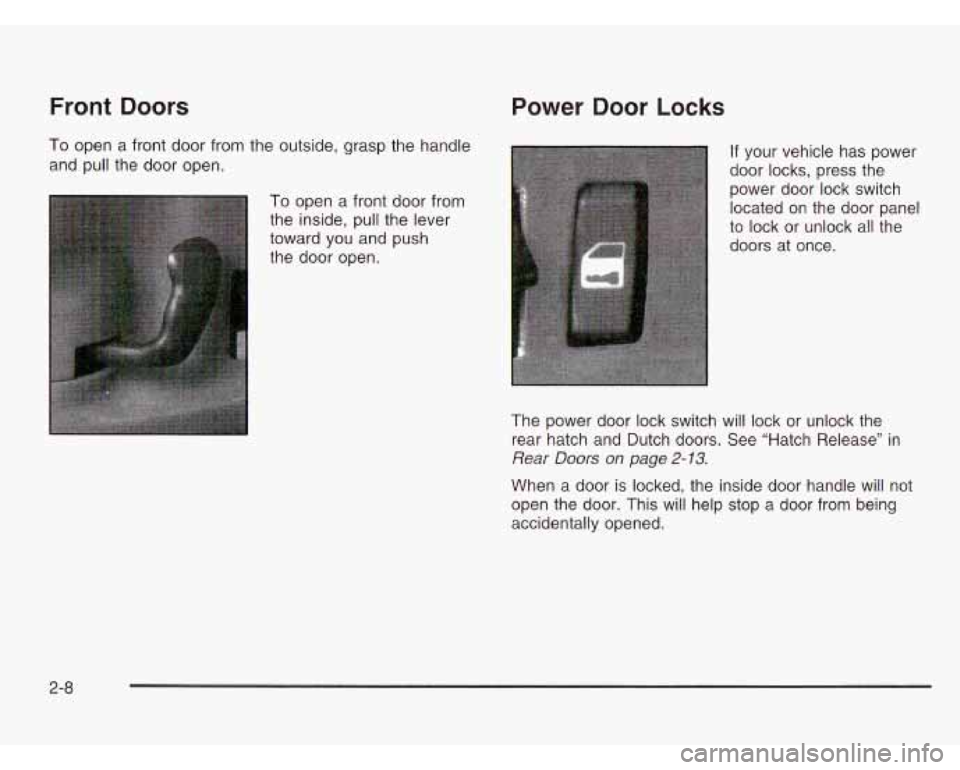
Front Doors
To open a front door from the outside, grasp the handle
and pull the door open.
To open a front door from
the inside, pull the lever
toward you and push
the door open.
Power Door Locks
If your vehicle has power
door locks, press the power door lock switch
located on the door panel
to lock or unlock all the
doors at once.
The power door lock switch will lock or unlock the
rear hatch and Dutch doors. See “Hatch Release’’ in
Rear Doors on page 2- 13.
When a door is locked, the inside door handle will not
open the door. This will help stop a door from being
accidentally opened.
2-8